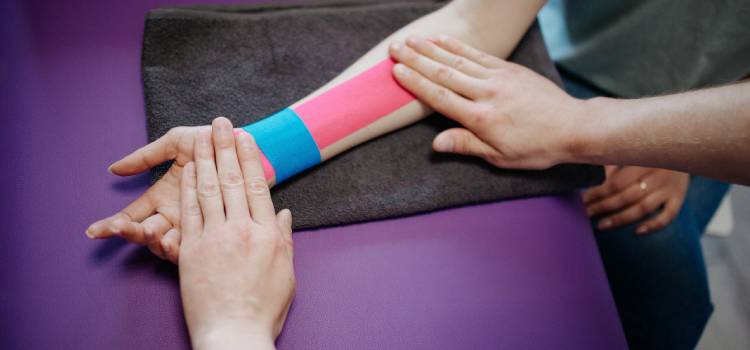In This Article
What can you do with a kinesiology degree? Education, duties and salary

Kinesiologists utilize their knowledge and skills to help athletes and dancers and are used frequently in sports physiology. However, kinesiology in the context of complementary medicine—a field known as applied kinesiology—is a holistic treatment.
Kinesiology schools attract a wide range of practitioners interested in holistic health, particularly chiropractors, naturopathic and conventional medical doctors, physical therapists, nurses, and massage therapists.
Kinesiology school graduates can be found throughout the health care and bodywork industries. But what all of these kinesiology careers have in common is their focus on using muscles as a diagnostic tool to pinpoint issues in the nervous system, lymphatic system, energy pathways, and other body systems.
What is kinesiology?
Kinesiology is the scientific study of human movement. And Applied Kinesiology (A.K.) is a form of therapy that combines science and exercise (like aerobic training, strength training, and yoga). It is used by healthcare professionals as a system of diagnosis and treatment.
Thus, the main goal of kinesiological practice is to detect, prevent and treat injuries, diseases, and other health conditions through specific exercises. These include:
Think of applied kinesiology as an approach that uses muscle testing in order to zero in on health problems throughout the body.
What does a kinesiologist do?
Kinesiologists study human movement through the evaluation, analysis, and prescription/rehabilitation of exercise and sports activities to determine why specific movements may hinder their performance or health.
The kinesiologist then determines appropriate physical therapies, herbal medicine, dietary changes, or other treatment methods to address the patient’s health issues and prevent future problems.
To help patients overcome physical injuries and disabilities kinesiologists use conventional diagnostic methods like laboratory tests as well as assessments that look at the structure and function of the musculoskeletal system. Including posture analysis, muscular control, motion analysis, and manual testing for areas of muscle weakness.
Skills kinesiologists use to help patients
Have you heard of Kinesiology Therapeutic (KT) tape? Often called ‘Kinesio tape’ and used to aid muscle movement, this innovation got its name from the field that studies movement—kinesiology.
How to become a kinesiologist in 7 steps
Earn your bachelor’s degree in kinesiology

Aspiring kinesiologists must first earn their bachelor’s degree in a program accredited by the Commission on Accreditation of Allied Health Education Programs (CAAHEP).
Attending a program with CAAHEP’s stamp of approval can set candidates on the path toward becoming a Registered Kinesiotherapist (RKT) which can, according to the American Kinesiotherapy Association (AKTA), enhance employment opportunities, assure the confidence of potential patients and increase your prestige among other allied health professionals.
Beyond seeking a program accredited by the CAAHEP, kinesiology majors should look for programs that fulfill the AKTA’s other prerequisites for becoming an RKT. Specifically, programs must include courses in:
• General psychology
• Human anatomy
• Human physiology
• Neurological and pathologic foundations of rehabilitation
• Exercise physiology
• Therapeutic exercise
• Applied Kinesiology
• Statistics
• Motor learning
• First aid
• Introduction to kinesiotherapy
In addition to simply taking these courses, you must earn at least a “C” in each class, and maintain a 2.5 (out of 4.0) grade point average (GPA).
Bachelor’s degrees typically take four years to complete and require students to have already earned their high school diploma or GED.
Gain 1,000 hours of supervised clinical experience

Once you’ve met the kinesiology degree requirements by earning your bachelor’s degree in a CAAHEP-approved program, you must then complete at least 1,000 hours of clinical experience supervised by an existing RKT.
Upon completion of these hours, the supervising RKT will need to submit a letter of sponsorship documenting your clinical hours before you can sit for the RKT exam.
Depending on your program, you might be able to complete all or some of your hours through applied kinesiology internships or externships. Be sure to check with your school to see what options are available.
Become an RKT

Once you complete the various prerequisites to sit for the AKTA’s Registered Kinesiotherapist (RKT) exam, you need to apply to take the exam and pay the fees associated with it. Currently, there are two fees: one to submit your documentation showing that you qualify to take the exam and a second to actually sit for it.
Be prepared to submit your academic transcripts and sponsorship letters documenting your clinical hours when you submit your application to take the exam. Once the AKTA has determined your eligibility, you’ll receive a written determination letter and details about your testing location and time.
The RKT exam is administered twice yearly in January and July. If you wish to take the January test, you must submit your application and supporting documentation by November 1, and by May 1 if you want to take the July test. Test takers are allotted two hours to complete the exam.
Begin practicing

After you pass the RKT exam, it’s time to apply your education and explore jobs in kinesiology. In general, kinesiologists are employed by various kinds of facilities and companies, not just medical practices and hospitals.
Common workplaces for kinesiotherapists include:
• Athletic and sporting goods companies
• Rehabilitation departments within medical facilities
• Occupational health practices and departments
• Fitness and recreation centers
• Professional sports teams
• Universities and colleges
Maintain your RKT status

After completing the work to qualify for and earn your RKT designation, keep it active. Your designation is valid for one year after passing the exam.
In order to retain this stamp of approval, RKTs must submit an application plus an associated fee, and complete at least 1.2 continuing education units (CEUs) to remain an RKT in good standing. These CEUs take a variety of forms including:
• Classes or webinars
• Research projects
• Publications by the therapist
• College-level coursework
• Performing lectures or seminars
One CEU is equivalent to 10 hours of coursework, and that coursework cannot be in CPR, first aid or waters safety.
Consider earning your master’s degree

While a bachelor’s degree is the base requirement for kinesiologists, those seeking to run their own practices or who simply wish to practice at a higher level should consider earning a master’s degree in kinesiology. Earning a graduate-level degree can open doors to positions in management and potentially lead to higher salaries.
A master’s degree will cover many of the same topics as an undergraduate program, but will typically dive more deeply into the subject matter. Additionally, while kinesiologists can certainly earn both their bachelor’s and master’s degrees in kinesiology, they can also choose to earn their master’s in a related field such as exercise science, dance therapy, physical therapy, nutrition, or healthcare management.
Depending on the degree you choose, you may be able to specialize in working with a particular kind of patient, perform interdisciplinary research or simply provide a more holistic level of care for your existing patients.
Consider becoming a certified specialist

Beyond the RKT designation, the AKTA allows kinesiologists who have held their RKT designation in good standing for at least three years to specialize in a variety of areas. Some include:
• Adaptive Sports
• Assistive Technology Professional
• Behavioral Health
• Cancer Rehabilitation
• Cardiac Rehabilitation
• Fall Prevention
• Functional Capacity Evaluation
• Geriatrics
• Orthopedics
• Posture Evaluation
• Research Specialist
• Senior Fitness Specialist
• Weight Management
Online kinesiology degrees
Those with a hectic schedule or simply a preference for an indirect form of education should consider pursuing high-quality, online kinesiology degrees. Kinesiology degrees can be earned from the associate level through to the doctoral level. However, most online options are offered at the associate’s and bachelor’s levels.
Online degrees typically cover the same topics and allow you the same, if virtual, access to your professors as those offered in person. Depending on the specific school and program, some in-person work might be required.
Flexible schedule
A degree earned online is generally regarded as equal to those earned through in-person programs by admissions councils and employers. However, there can be significant differences in the experience of students pursuing degrees online.
For instance, online degrees can be more flexible both in the times you select to take your classes as well as in the amount of time it takes you to earn your degree. Online programs are often offered “asynchronously” meaning that you needn’t necessarily participate in lectures at the time the lectures are given—you can run through the course at your own pace.
Earn a degree faster (or slower)
This means that if you’re able to complete your lessons and work more rapidly than students on campus, you could earn your degree more quickly than a traditional program would allow. Conversely, if your existing commitments don’t allow you to progress as quickly as a full-time, in-person student, you can take the time you need to complete your degree at a pace that works for you.
Kinesiology compared to similar professions
Kinesiology is often compared to physical therapy, sports medicine, and chiropractic work. Let’s look at the similarities and differences between what a kinesiologist does and their related counterparts.
Kinesiology vs. exercise science
Exercise science and kinesiology both focus on physical mobility and promoting the healthiest forms of physical activity. While kinesiology pays more mind to human movement in everyday activities, exercise science specializes in human mobility with an emphasis on exercise-specific activities. Some, however, consider exercise science a specialized form of kinesiology.
Kinesiology vs. chiropractors
Chiropractors may benefit from studying kinesiology as it focuses on human mobility, and both fields of study heavily focus on healthy human mobility as well as overall joint and muscle comfort. Unlike chiropractors, kinesiologists do not use direct manipulation with thrusting or forceful touch.
Kinesiology vs. physical therapy
Physical therapy utilizes exercise and specific stretching or movements to recover from injury or gain strength. Kinesiology studies the mobility of living organisms rather than the recovery or growth of a specified body part. However, a strong understanding of kinesiology can be a great tool for physical therapists and their PTAs.
Kinesiology to med school?
Many practitioners who earn a kinesiology degree go on to work in different areas of medicine. Therefore, many who earn a degree in kinesiology learn valuable information that can translate to other similar jobs. A degree in kinesiology may prepare candidates for physician’s assistant school or even medical school.
Furthermore, candidates may find the training and experience in a kinesiology degree plan ample enough to allow a streamlined transition into nursing or chiropractic school. A kinesiology degree can be a valuable key to opening up “doors of opportunity” in medicine.
Kinesiology salary (state by state comparison)
How much does a kinesiologist make? Exercise physiologists, the category under which kinesiologists are classified, earn an annual median salary of $54,860, according to the U.S. Bureau of Labor Statistics (BLS) data. Find your state’s figure and compare below:
Of course, an individual’s kinesiology salary can vary greatly depending on a number of factors including location, experience, workplace, and education. For instance, kinesiotherapists in the Los Angeles metropolitan area earn more than those in the Detroit metro area based on cost of living.
Kinesiologist salary compared to related fields
Because graduates of kinesiology schools may practice in a variety of professions, you can compare salaries of relevant related career paths, such as athletic trainers, and estimate earning potential.
Highest paying metros for kinesiology degree jobs
You may have guessed that Los Angeles would make the list. But would you have guessed Cleveland, OH, or Colorado Springs, CO would make the cut as well?
Kinesiology job demand and outlook
The BLS projects that exercise physiologists employment will grow by 10.2% through 2032, adding an estimated 1,900 jobs in the field during that time. This rate of growth is faster than the average for all occupations.
States with the highest employment of kinesiotherapists include:
| State | Employed | Hourly Wage | Annual Mean Wage |
|---|---|---|---|
| Texas | 630 | $24.37 | $50,690 |
| Michigan | 510 | $23.96 | $49,840 |
| Florida | 400 | $25.27 | $52,570 |
| Illinois | 370 | $26.72 | $55,580 |
And according to research collected by the International College of Applied Kinesiology, each year brings more positive findings on the effectiveness of kinesiology training as a complementary diagnostic tool.
Kinesiology school may be a good choice if you have an interest in preventive medicine and complementary diagnostic methods. As more Americans begin to rely on holistic and preventive medicine for their overall wellness, kinesiologists have reason to be optimistic about their job outlook.
How to earn an applied kinesiology certification
For most kinesiology degrees approved by the International College of Applied Kinesiology, basic training includes 100 hours of study.
Although 100 hours of basic training qualify health care and bodywork professionals to practice applied kinesiology, Diplomate-level certification requires 300 hours of advanced courses at a kinesiology school approved by the International College of Applied Kinesiology.
In addition, medical, massage therapy, and health care professionals must meet appropriate state licensing requirements for their profession in order to use their kinesiology training in a clinical or therapeutic setting.
How to earn clinical specialization as a kinesiotherapist
“The clinical specialization program has been established as a means to formally recognize the Registered Kinesiotherapist who has built upon his or her foundational professional education, as established in the Kinesiotherapy Scope of Practice. Clinical specialization is a voluntary process, initiated at the request of the RKT. COPSKT recognizes individuals who have attained an advanced level of knowledge and skill in each specialty area with approved training thru certifying bodies,” the AKTA website states.
In order to earn your certification, which can give you a competitive advantage while searching for work and negotiating salaries for kinesiology careers, the AKTA requires candidates to:
Once candidates have completed those prerequisites, they must submit their application and fee to the AKTA. If approved, your certification lasts two years and then must be renewed.

Written and reported by:
Joe Edwards
Staff Writer
Updated: September 1, 2021
